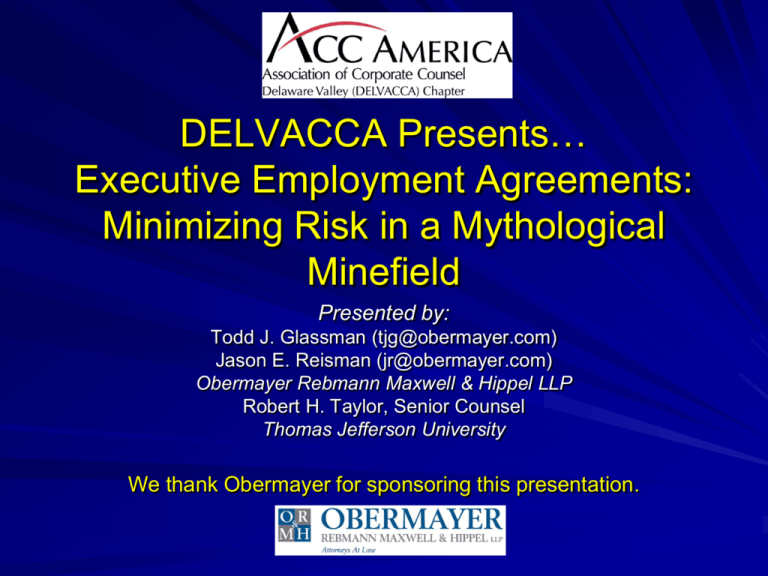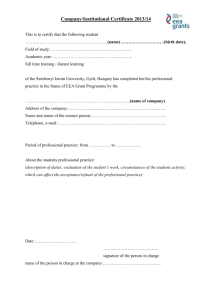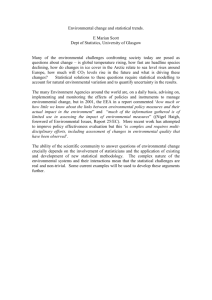DELVACCA Presents… Executive Employment Agreements
advertisement

DELVACCA Presents… Executive Employment Agreements: Minimizing Risk in a Mythological Minefield Presented by: Todd J. Glassman (tjg@obermayer.com) Jason E. Reisman (jr@obermayer.com) Obermayer Rebmann Maxwell & Hippel LLP Robert H. Taylor, Senior Counsel Thomas Jefferson University We thank Obermayer for sponsoring this presentation. Introduction The focus of today’s presentation is not on the typical, one-sided “standard” at-will employment agreement. This presentation assumes that the parties have already agreed upon compensation and benefits (i.e., negotiated a term sheet). 2 Introduction The Company is voluntarily creating obligations on itself greater than those required by law under the “at-will” employment doctrine. The Executive enjoys rights greater than those granted by law under the “at-will” employment doctrine. 3 Background: So how does it end? When employment is not “at-will,” one of the parties will typically end the employment relationship in one of four ways: – The Company terminates employee for “Cause” – The Company terminates employee without “Cause” – The Executive terminates employment for “Good Reason” – The Executive terminates employment without “Good Reason” 4 Other ways that it may end… Death Disability Retirement Change in Control 5 The Company’s Perspective 1. What matters in “real life”? – Few provisions of an executive employment agreement (“EEA”) are ever negotiated by the Executive. 2. What matters in litigation? – The majority of the provisions in an EEA are boilerplate-type concepts that become critical only in litigation (or pre-litigation negotiations). 6 Executive’s “Real-Life” Concerns Typically, the Executive will have reason to negotiate only three elements of an EEA: – 1. Severance Package – 2. Definition of “Cause” – 3. Post-Employment Restrictions 7 What Executives Want: 1. The Severance Package Salary Continuation (or Lump Sum Payout) Health & Welfare Benefits – Benefits during salary continuation – Reimbursement of COBRA Commission Tail Accelerated Vesting of Equity Grants Extended Exercise Periods for Stock Options 8 What Executives Get: NOTHING*** ***The Company should never agree to provide post-employment benefits absent the Executive’s agreement to execute a general release at the time of termination of employment and prior to the Executive’s receipt of post-employment benefits. The Company may wish to attach that general release to the EEA. 9 What Executives Want: 2. Narrow/Objective “Cause” Definition The Company’s termination of the Executive for “Cause” disentitles the Executive to severance benefits. General Company view: the broader the better. Consider Executive right to cure. 10 “Cause” Defined Element: Convictions – Felony – Crimes of Moral Turpitude – Any Crime Narrow example: The Executive’s conviction of or plea of guilty or nolo contendere to a felony, a crime of falsehood or a crime involving moral turpitude Broad example: The Executive’s conviction of or plea of guilty or nolo contendere to a crime 11 “Cause” Defined Element: Misconduct Narrow: Any gross misconduct or violation of law which is materially injurious to the operations, financial condition or business reputation of the Company Broad: Any misconduct or violation of law which is injurious or potentially injurious to the operations, financial condition or business reputation of the Company 12 “Cause” Defined Element: Violation of Company Policy Narrow: Willful, material violation of any written Company policy in effect as of the effective date of the EEA Broad: Violation of any written Company policy 13 “Cause” Defined Element: Breach of EEA Narrow: The Executive’s intentional breach of a material provision of this Agreement Broad: The Executive’s breach of any provision of this Agreement 14 “Cause” Defined Element: Performance Narrow: The Executive’s willful failure to perform her duties to the Company (other than a failure resulting from the Executive’s incapacity because of physical or mental illness, as provided in the EEA), which failure results in monetary injury to the Company; or the Executive’s willful failure to follow the good faith, lawful instructions of her direct supervisor or the Company’s Board of Directors with respect to the operations of the Company Broad: The Executive’s continued failure to substantially perform her duties under the EEA or to follow the lawful and reasonable directions of her supervisor or the Board 15 Other “Cause” Elements Misappropriation/Fraud Discrimination/Harassment Failure to Report to Work Dishonesty or Gross Negligence/Misrepresentation Breach of Fiduciary Duty Substance Abuse Breach of Pre-Existing Restrictive Covenant or Duty of Confidentiality 16 Some “Cause” ‘Wiggle Words’ Material Substantial Gross Reckless Willful/Intentional Reasonable Arbiter of conduct (reservation of discretion) 17 Without “Cause” Defined: An Important Intricacy to Consider Whether non-renewal by the Company of an EEA that is for a term of years constitutes a without “Cause” termination will determine whether the Executive shall receive severance benefits upon the expiration and non-renewal of an EEA. 18 Hmmm… Bill Oliver joined Acme’s executive team in January 2008 following an impressive track record at Big Retailer. As Acme’s EVP for Strategic Planning, Mr. Oliver entered into an EEA that could provide cash and equity of about $20 million over five years. Acme officials have determined that Oliver fostered an inappropriate relationship with the teenaged daughter of another Acme employee (a manager who reports to Oliver) and believes Oliver’s employment should be terminated. Oliver’s employment contract contains the following definition of acts which could warrant termination for cause: – “Any gross misconduct or violation of law which is materially injurious to the operations, financial condition or business reputation of the Company.” The CEO of Acme seeks your legal advice regarding Mr. Oliver’s employment. What do you recommend? Why? 19 Good Reason: The Dark Side of “Cause” Examples of “Good Reason” for the Employee to terminate her employment and receive severance benefits: – the Company’s substantial diminution of the Executive’s duties and responsibilities – a material reduction in the Executive’s salary or benefits, except such reductions that are “across the board” – a reassignment which requires the Executive to move his principal office more than fifty (50) miles from the Executive’s office on the date of the entry of the EEA Consider Company right to cure 20 Change in Control Standard change in control benefits may involve a cash bonus and/or accelerated vesting. The Executive may seek enhanced severance benefits following a change in control and (1) a no “cause” termination by the Company or (2) the occurrence of an event giving rise to “good reason” for the Executive to terminate employment. The Company will usually tie enhanced severance benefits to timing in relation to the change in control. 21 What Executives Want: 3. “Non-Restrictive” PostEmployment Restrictions 1. Covenant not to compete 2. Covenant not to solicit/interfere 3. Covenant not to raid employees 4. Covenant to protect trade secret, proprietary and confidential information 22 Covenants Not to Compete (PA) 1. Continued employment is not sufficient consideration to support a non-competition or non-solicitation agreement. 2. Notify prospective Executive that his or her EEA will contain restrictive covenants & provide a copy in advance of first day of employment. 3. Obtain the Executive’s signed EEA on or prior to first day of employment. (You’d be surprised!) 23 Covenants Not to Compete (PA) 4. Make copies and keep original EEA and copies in secure area. (You’d really be surprised!) 5. Carefully consider the wording of restrictive covenants (e.g., “indirectly solicit” versus “solicit through another person or entity”). 6. Covenants not to compete are restraints on trade and, as such, are inherently disfavored by Courts. So… 24 Covenants Not to Compete (PA): Think before you draft! 1. Carefully consider the restricted activities and the geographical and temporal scope. 2. Court will apply a fact-specific, reasonableness standard. 3. To be enforceable, a restrictive covenant must be: – Ancillary to an employment relationship; – Supported by adequate consideration; – Reasonably necessary for the protection of legitimate interests of the employer; and – Reasonably limited in duration and geographic extent. 4. Balancing test: A court will balance the employer’s legitimate business interests against the interest of the employee in earning a living in his or her chosen profession, trade or occupation, and will then balance the result against the interest of the public. 4. Now that we’ve got that cleared up…what’s reasonable? 25 Restrictive Covenants: What’s Reasonable? You’ll find out!!! (After the fact, unfortunately…) To minimize risk, restrict what you need, not what you want. Be careful of “boilerplate restrictive covenants.” 26 Other Protections Related to Restrictive Covenants Contractual requirement for the Executive to notify subsequent employer of restrictions and to provide a copy of EEA Contractual consent for the Company to provide notice of restrictions to a subsequent employer Contractual requirement for the Executive to notify the Company of identity of subsequent employer and title/duties regarding subsequent employment The Company may obtain right to cease severance payments if the Executive has breached his or her restrictive covenants (and to recoup previous payments made) 27 Hmmm… On July 8, 2010, Acme terminated Mr. Oliver’s employment due to his inappropriate relationship with the teenaged daughter of another Acme employee. Shortly thereafter, Oliver filed a lawsuit alleging Acme owes him the balance of the compensation set forth in his contract, or roughly $12 million. Acme has retained outside counsel to defend the lawsuit. However, on September 15, 2010, Acme learned that Oliver had joined Big Competitor, as its SVP for Strategic Planning. The CEO of Acme views this as unacceptable, given the knowledge that Oliver has of Acme’s business plans. The CEO reminds you that Mr. Oliver has a two year non-compete provision in his employment contract, and says that he wants to seek enforcement of that provision. Yikes! 28 Confidential Information 1. What’s really confidential? (e.g., customer identity versus customer decision-maker identity) 2. How to define: general or specific? – General: “All knowledge, information, material or data about the Company or its business disclosed to or learned by the Executive through his employment with the Company, whether or not specifically designated by the Company as confidential, which is proprietary and/or confidential, and including any information the Company has developed or develops that is not known to the Company’s competitors and which provides the Company a competitive advantage.” 29 Confidential Information – Specific (a/k/a the “Rolodex Definition”): “The Company’s Confidential information includes: (i) Financial data, vendor pricing to the Company, vendor lists, computer printouts, accounts receivable reports, revenue reports, cost reports, budgets, profit and loss reports, sales figures and sales targets; (ii) Customer lists, customer contacts, potential customer contacts, targeted potential customers, rolodex(es), sales territories, sales strategies, proposals and contracts; (iii) Employee lists, employee salaries, memoranda, samples, notes, books, correspondence, all written and graphic records belonging to the Company and in the Executive’s possession or under the Executive’s control; (iv) Such other Company information designated as confidential, proprietary and/or trade secret to which the Executive gains access during his employment; and (v) All documents, files, correspondence, notes or other papers memorializing or containing any such information.” 30 What Matters In Litigation? Specific to Restrictive Covenants – Provide for the Company’s right to obtain attorneys’ fees and costs for the Executive’s breach – Set forth the Executive’s acknowledgment of irreparable harm and consent to the Company’s right to obtain injunctive relief – Provide for a court’s ability to blue-pencil an overbroad restriction (in a blue-pencil state) 31 What Matters In Litigation? Integration (“Entire Agreement”) clause This is the entire Agreement that exists between the parties and supersedes all other agreements and understandings between the parties, written or verbal. Prevents use of extrinsic evidence in interpreting EEA in the event of a dispute over its terms. 32 What Matters In Litigation? Choice of Law/Consent to Venue The parties agree that the terms of this Agreement shall be construed in accordance with the laws of the Commonwealth of Pennsylvania. In the event of any dispute arising under this Agreement, the parties consent to the jurisdiction of the courts located within Pennsylvania. Understand the intricacies of the state in which you wish for the agreement to be enforced and litigated. 33 What Matters In Litigation? Severability (especially restrictive covenants) If any provision of this Agreement or its application to anyone or under any circumstances is adjudicated to be invalid or unenforceable, such invalidity or unenforceability shall not affect or impair in any way the validity, legality or enforceability of the remainder of this Agreement, and shall not invalidate or render unenforceable such provision or application in any other jurisdiction. Ensures that the Company avoids the legal principle that the presence of one legally invalid contract provision impacts the enforceability of other otherwise enforceable provisions. 34 What Matters In Litigation? No Drafting Parties The parties acknowledge and agree that each has fully participated in the negotiation and drafting of this agreement and, as such, neither party shall be considered the drafter of this agreement. As such, this agreement shall not be construed either for or against either party in that regard. Addresses the principle of law that a contractual ambiguity shall be construed against the drafter (i.e., the Company) of the agreement. 35 What Matters In Litigation? Non Waiver of Breach The failure of either party to enforce any provision or provisions of this Agreement shall not be construed as a waiver of any such provision or provisions as to any future violations thereof, nor prevent that party thereafter from enforcing each and every other provision of this Agreement. The rights granted herein by and to the parties are cumulative and the waiver of any single remedy shall not constitute a waiver of such party’s right to assert all other legal remedies available to it under the circumstances. Ensures that the Company’s failure to enforce a right under the agreement is not affected by the Company’s waiver of enforcement of another contractual right. 36 What Matters In Litigation? No Modification The parties agree that this Agreement may only be amended by an instrument in writing executed by the parties hereto, and that neither party shall assert that this Agreement has been modified in any manner other than by written instrument. Prevents a party from asserting that the parties modified an EEA orally or by their course of conduct. 37 What Matters In Litigation? Successors and Assigns This Agreement shall not be assignable by any party, except by Company to any successor in interest to its respective businesses. In some states, the Company’s failure to contract for its right to assign an EEA upon its sale of business will preclude the Company from automatically assigning the EEA to the successor. 38 What Matters In Litigation? Jury Trial Waiver/ADR – Litigation v. ADR – If litigation, waive right to jury trial? – Jury trial waiver must be “knowing and voluntary”: whether a gross disparity in bargaining power existed between parties business or professional experience of the party opposing the waiver whether the clause containing the waiver was inconspicuous whether the opposing party had an opportunity to negotiate contract terms – Types of ADR to consider: mediation, arbitration or both – split venues for injunctive (in court) v. non-injunctive (in arbitration) relief 39





